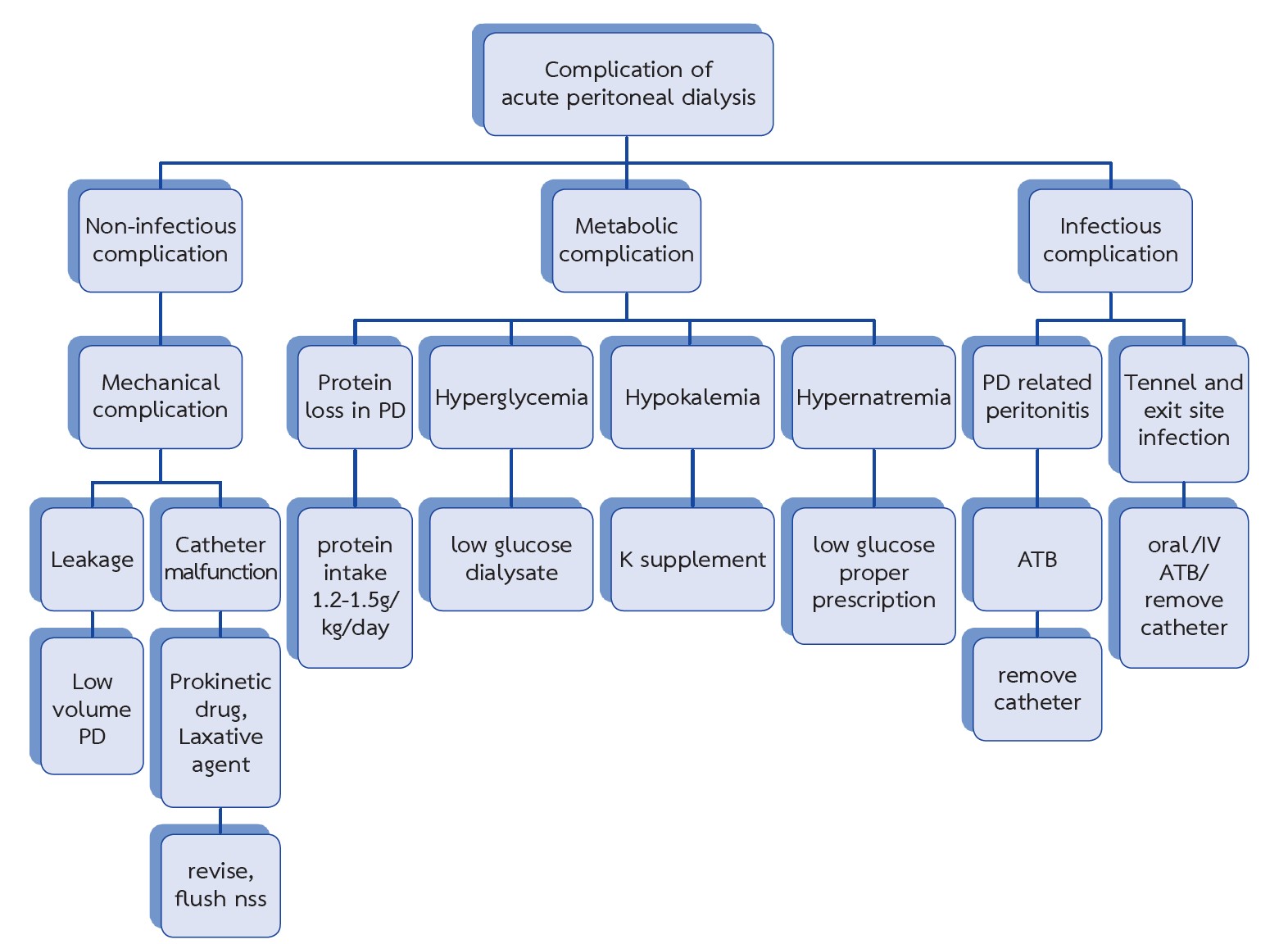Peritoneal Dialysis in Acute Kidney Injury and Related Complications
Main Article Content
Abstract
In regions of the world where resources are limited, acute peritoneal dialysis may provide safe, effective and cheaper alternative to acute hemodialysis with comparable efficacy. Acute peritoneal dialysis can be performed quickly and conveniently, requires fewer skilled personnels and less technologies. Current evidence suggest non-inferior outcomes compared to hemodialysis in the setting of acute kidney injury. Factors that may influence adverse outcomes include patient’s overall condition, the severity of underlying diseases, complications related to dialysis catheter replacement and peritoneal dialysis techniques such as intraabdominal infection, leakage of dialysis fluid, blockage of the catheter, and electrolyte abnormalities. These complications may result in switching to hemodialysis in up to 10-15 percent of the patients. Nevertheless, prevention of these complications may be achieved through thorough risk assessment prior to the procedure. Moreover, proper patient’s preparation prior to the procedure including administration of antibiotics, placement of urinary catheter, using laxative, placement of peritoneal catheter by a trained personnel and prompt recognition of complications can help reduce the length of hospital stay, morbidity and mortality in this setting.
Article Details

This work is licensed under a Creative Commons Attribution-NonCommercial-NoDerivatives 4.0 International License.
This article is published under CC BY-NC-ND 4.0 license, which allows for non-commercial reuse of the published paper as long as the published paper is fully attributed. Anyone can share (copy and redistribute) the material in any medium or format without having to ask permission from the author or the Nephrology Society of Thailand.
References
Gabriel DP, Nascimento GVR, Caramori JT, Martim LC, Barretti P, Balbi AL. Peritoneal dialysis in acute renal failure. Ren Fail. 2006;28(6):451–6.
Firmat J, Zucchini A. Peritoneal dialysis in acute renal failure. Contrib Nephrol. 1979;17:33–8.
Cullis B, Al-Hwiesh A, Kilonzo K, McCulloch M, Niang A, Nourse P, et al. ISPD guidelines for peritoneal dialysis in acute kidney injury: 2020 update (adults). Perit Dial Int J Int Soc Perit Dial. 2021 Jan;41(1):15–31.
Chionh CY, Soni SS, Finkelstein FO, Ronco C, Cruz DN. Use of Peritoneal Dialysis in AKI: A Systematic Review. Clin J Am Soc Nephrol. 2013 Oct 7;8(10):1649–60.
Ponce D, Gobo-Oliveira M, Balbi AL. Peritoneal Dialysis Treatment Modality Option in Acute Kidney Injury. Blood Purif. 2017;43(1–3):173–8.
Vaamonde CA, Michael UF, Metzger RA, Carroll KE. Complications of acute peritoneal dialysis. J Chronic Dis. 1975 Dec;28 (11–12):637–59.
Li PK-T, Szeto CC, Piraino B, de Arteaga J, Fan S, Figueiredo AE, et al. ISPD Peritonitis Recommendations: 2016 Update on Prevention and Treatment. Perit Dial Int. 2016 Sep 1;36(5):481–508.
Liu L, Zhang L, Liu GJ, Fu P. Peritoneal dialysis for acute kidney injury. Cochrane Database Syst Rev. 2017 Dec 4;12:CD011457.
Ricardo Correa-Rotter , Rajnish Mehrotra , Anjali Bhatt Saxena .Brenner and Rector’s The Kidney.11th Edition, Philadelphia:Elsevier ;2020.p. 2094-2117.
Szeto C-C, Kwan BC-H, Chow K-M, Law M-C, Pang W-F, Chung K-Y, et al. Recurrent and Relapsing Peritonitis: Causative Organisms and Response to Treatment. Am J Kidney Dis. 2009 Oct 1;54(4):702–10.
Schwartz FD, Kallmeyer J, Dunea G, Kark RM. Prevention of Infection During Peritoneal Dialysis. JAMA. 1967 Jan 9;199(2):79–81.
Eriguchi M, Tsuruya K, Yoshida H, Yamada S, Tanaka S, Suehiro T, et al. Validation of the Exit-Site Scoring System Recommended by the 2005 Guidelines of the International Society for Peritoneal Dialysis. Perit Dial Int. 2011 Nov 1;31(6):698–700.
Chadha V, Warady BA, Blowey DL, Simckes AM, Alon US. Tenckhoff catheters prove superior to cook catheters in pediatric acute peritoneal dialysis. Am J Kidney Dis Off J Natl Kidney Found. 2000 Jun;35(6):1111–6.
Ansari N. Peritoneal Dialysis in Renal Replacement Therapy for Patients with Acute Kidney Injury. Int J Nephrol. 2011 Jun 8;2011:e739794.
Xu D, Liu T, Dong J. Urgent-Start Peritoneal Dialysis Complications: Prevalence and Risk Factors. Am J Kidney Dis. 2017 Jul 1;70(1):102–10.
Leblanc M, Ouimet D, Pichette V. Dialysate leaks in peritoneal dialysis. Semin Dial. 2001 Feb;14(1):50–4.
Sojo ET, Grosman MD, Monteverde ML, Bailez MM, Delgado N. Fibrin glue is useful in preventing early dialysate leakage in children on chronic peritoneal dialysis. Perit Dial Int J Int Soc Perit Dial. 2004 Apr;24(2):186–90.
Al-Hwiesh AK. Percutaneous Peritoneal Dialysis Catheter Insertion by a Nephrologist: A New, Simple, and Safe Technique. Perit Dial Int J Int Soc Perit Dial. 2014;34(2):204–11
Shanmugalingam R, Makris A, Hassan HC, Li Y, DeGuzman I, Nandakoban H, et al. The Utility of Sonographic Assessment in Selecting Patients for Percutaneous Insertion of Peritoneal Dialysis Catheter. Perit Dial Int J Int Soc Perit Dial. 2017 Aug;37(4):434–42.
Ash SR. Peritoneal Dialysis in Acute Renal Failure of Adults: The Under-Utilized Modality. Sepsis Kidney Mult Organ Dysfunct. 2004;144:239–54.
Boyer J, Gill GN, Epstein FH. Hyperglycemia and hyperosmolality complicating peritoneal dialysis. Ann Intern Med. 1967 Sep;67(3):568–72.
Berlyne GM, Lee HA, Ralston AJ, Woolcock JA. Pulmonary complications of peritoneal dialysis. Lancet Lond Engl. 1966 Jul 9;2(7454):75–8.


